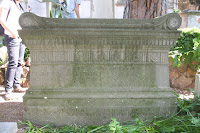Week 4 of 12
Module 3: Material Characteristics and as a Building Material
Today we were joined by Rand Eppich, an architect and documentation specialist, leading us on the topic 'Documentation and Recording'. A document titled 'Principles for the Recording of Monuments, Groups of Buildings and Sites' was ratified by ICOMOS in 1996. The Getty Conservation Institute has also published several documents covering the guiding principles for documentation which Rand advises should be followed for every conservation project undertaken. We have been given copies of volumes 1 and 2 of 'Recording, Documentation, and Information Management for the Conservation of Heritage Places', both available in PDF format on the GCI website.
I frequently use Google Maps in my work to locate certain buildings, but Rand has told us that on Google Earth it is now possible to see historical imagery in the form of maps and photographs (including satellite photographs)- I have yet to test it out. Rand believes that 90% of conservation projects can be carried out with simple measurement systems and photography without the need for expensive additional techniques. A simple tool bag for this work would include the following; spirit level, tape measure, clipboard, plumb bob, pencil, camera, colour bar and tripod.
In the second half of the morning session Rand gave us details about good photography for documentation and information about removing the radial distortion from images to enable a photograph to be turned into a document for carrying out data collection. Tomorrow we will be meeting for an additional session to trial this technique but Rand has given us a link to a piece of software available on the internet that can do this task.
This afternoon we went for our first visit to the Non-Catholic Cemetery to make drawings, measurements and photographs of the tombs that we have been assigned as our projects for week 11 of the course. The tomb I am working on with Anita (the Australian Participant) is dated 1918 and is very detailed with many fine carvings, but is made from a very soft stone and is flaking and cracking in several areas. There is also quite a range of biological growth on the surface including lichens, and we will need to establish if this is causing problems for the stonework- hopefully we will be covering this in future lectures.
The tomb of Florence Baldwin (deceased 1918) which I will be working on to develop a conservation plan and implement the work in week 11 of the course.

No comments:
Post a Comment